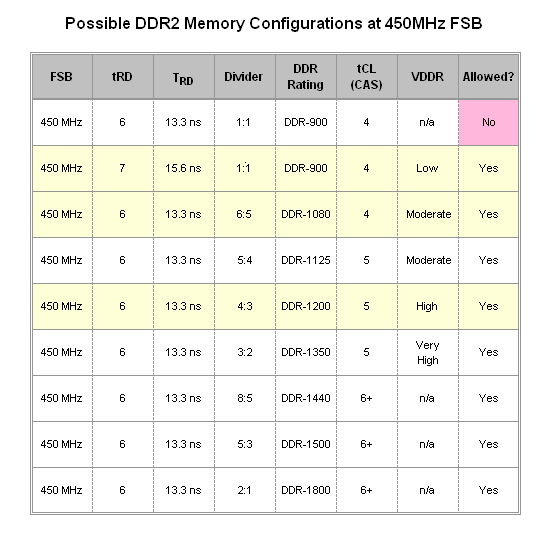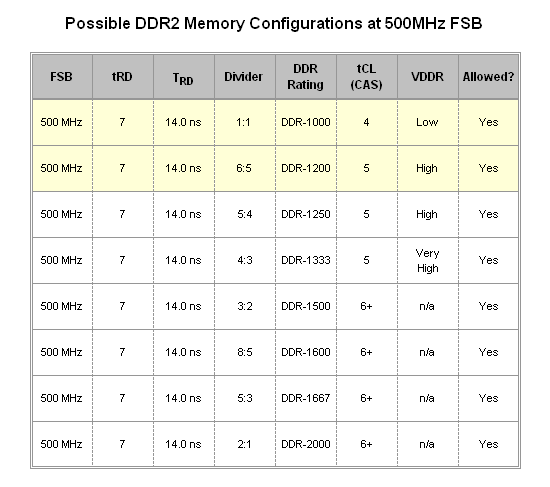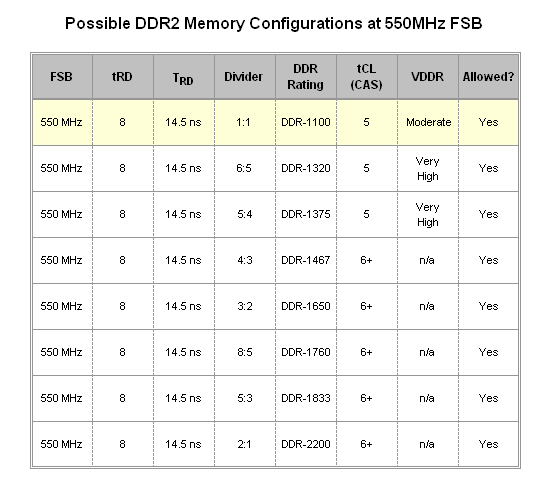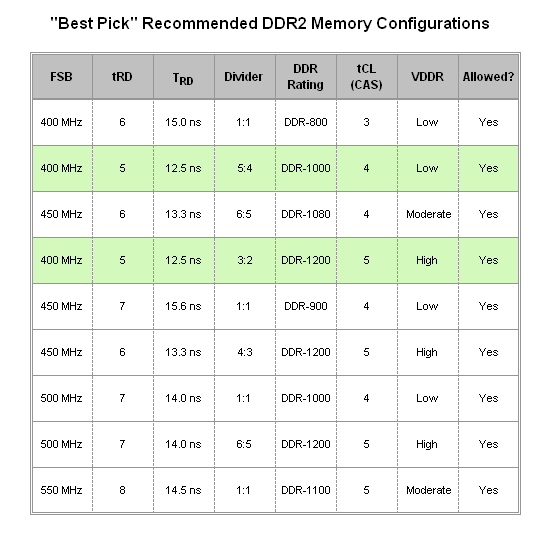ASUS ROG Rampage Formula: Why we were wrong about the Intel X48
by Kris Boughton on January 25, 2008 4:30 AM EST- Posted in
- Motherboards
How to Choose an Appropriate Memory Configuration
Now that we have seen what impact tRD can have on memory performance, and we know how to determine whether certain memory configurations will work or not, the easiest way to go about deciding how to set up memory is to concentrate this knowledge into a table of candidates and then choose the best one. As you can see below, we have done just that.
Four target FSB frequencies (400, 450, 500 and 550MHz) were used in the construction of these tables. We chose these values because they represent the approximate best-case bus speeds for each tRD setting of concern (5, 6, 7, and 8). As we wrote earlier, the MCH can be overclocked in both the traditional sense - by raising the FSB - or by simply lowering the tRD from the default value at a specific bus speed. When these two effects are combined, the resulting strain on the MCH often requires a considerable amount of extra voltage in order to maintain stability. Because of this, MCH base operating frequency (i.e. FSB) increases detract from the ability to achieve the same low TRD values available at lower bus speeds. One of these two approaches to overclocking the MCH must be better than the other - the only question is which one is best? As it turns out the answer involves a delicate balance for each approach. Before we review our final recommendations, let's look at the contenders.

For the 400MHz FSB case three configurations stand out in particular - 1:1 for DDR2-800, CAS 3; 5:4 for DDR2-1000, CAS 4; and 3:2 for DDR2-1200, CAS 5. Of these three the last two are actually more appealing, not only because they offer the potential for higher memory bandwidths but also because a tRD of 5 is allowed for these configurations whereas CAS 3 operations using a 1:1 divider at 400MHz FSB is not possible with a tRD of 5. These results can be predicted using the "POST Test Equation" provided on the previous page. Those that choose to operate at 400MHz FSB (assuming this bus speed can be appropriately matched with one of their processor's available multipliers) need to decide whether to run the 5:4 or 3:2 divider. The decision might come down to the amount of memory being used - DDR2-1200 can be a rather lofty goal with four DIMMs installed, in which case DDR2-1000 would be the next best choice.

Moving on to the analysis at 450Mhz FSB, although we are able to show impressive memory read speeds at this same bus frequency using a 3:2 divider for DDR2-1350 CAS 5 at a tRD of 5, this configuration was far from stable on stock cooling alone - as was the memory speed. Most likely, the need to loosen tRD to 6 will be inevitable at this bus speed. Right from the start, we can see that TRD takes a hit as our minimum values thus far came at the lower 400Mhz FSB. What's more, possible memory configurations at this FSB do not seem to offer any real improvement over those at 400MHz. The first option worth considering, DDR2-900 at CAS 4, can be a little slow, especially considering that a tRD of 6 is not allowed. The DDR2-1200 choice will provide (at best) only miniscule gains over the same memory speed at 400MHz FSB because of the additional throughput efficiency made possible by the higher bus speed. Then again, the increase in TRD to 13.3ns, up from the minimum value of 12.5ns at 400MHz FSB, may completely negate any chance of a performance gain. Our last contender, DDR2-1080 at CAS 4, might be another neutral choice - on one hand there could be a small gain in performance over DDR2-1000 (CAS 4) seen at 400MHz FSB, but again the higher TRD may be this configuration's undoing.

The meaningful choices at 500MHz FSB are even bleaker - here we find only two that merit any kind of attention (although you might be able to argue a point for the DDR2-1250 configuration). Having to further loosen tRD to 7 only compounds the issue of the slipping TRD value that we first saw at 450MHz FSB. On top of this, the DDR2-1000 CAS 4 and DDR2-1200 CAS 5 memory speeds are not unique to this FSB, effectively removing any incentive in choosing this bus frequency. Furthermore, the 4:3 and greater dividers are practically worthless as they attempt to push DDR2 memory to mostly unattainable speeds. Considering this, there is only one reason we would ever recommend bus speeds this high and that would be in the case of a severely limited CPU multiplier in which the extra FSB is required by the processor alone.

Without a doubt, 550MHz FSB represents the coup de grâce of ridiculously high bus speeds with only one divider (1:1) providing any substance to this horrible choice in settings. Again, we see the uncontrollable relaxation of TRD (at 14.5ns), which when coupled with a memory configuration of DDR2-1100 at CAS 5 certainly does not create a situation worth writing home about. Why anyone would choose to run their system this way is beyond us.
If there is one thing our studies here should teach us, it's the futility of searching for maximum performance in outrageously high bus speeds. Truthfully, we would argue that the best selections are possible at the "low" FSB of 400Mhz. Let us make it perfectly clear by saying that none of us here at AnandTech would ever tell you that 400Mhz FSB is an inferior choice. In fact, many of us make heavy use of this exact bus speed when setting up our personal systems for daily use. In the interest of fairness, let's take one last look at all of the highlighted configurations from the tables above.

When viewed together the task of picking out a couple of the best choices becomes rather simple. A+ ratings, of course, go to the two configurations colored in light green (5:4 for DDR2-1000 CAS4 and 3:2 for DDR2-1200 CAS 5). You may be surprised, as we mentioned earlier, that they both use a humble 400MHz bus speed. If forced to choose another option, close second place awards might go to 450Mhz FSB - 1:1 and DDR2-900 CAS 4, or 4:3 DDR2-1200 CAS 5 (assuming your motherboard is capable of stable operation with the sometimes poorly implemented 4:3 divider). Just do not forget - whatever memory option you choose, be sure to remember the importance of tRD.


In the end we decided to run our Intel Core 2 Extreme QX9650 at a final FSB of 400MHz with a multiplier of 10.0x at an even 4GHz. Our 4x1GB of OCZ DDR2 PC2-8000 Platinum Extreme Edition memory was set to run at DDR2-1000 (5:4) CAS 4 with a tRD of 5. Ultimately, the ASUS Rampage Formula provided us the ability to build a well-tuned system. Without question, ASUS' addition of BIOS options for direct tRD manipulation was instrumental to our successful overclock. When paired with top-end GPUs from either ATI or NVIDIA, our rig becomes a formidable gaming platform for enjoying today's titles and beyond.










73 Comments
View All Comments
DragonStefan - Tuesday, June 9, 2009 - link
Hello all.I have:
- motherboard: ASUS Rampage Formula (Intel X48) (logical) and
- Corsair XMS2 Dominator Series 2x2048MB Kit PC2-8500 CL5-5-5-15 (TWIN2X4096-8500C5D)
Should i go for the following setup in bios:
FSB: 400
tRD: 5
Trd: 12,5
Divider: 3:2
tCL: 5
VDDR: High
Allowed: Yes.
Or should i go for a different setup?
If i understand correctly, this is possible..
What do i forget?
I made the calculation, and the answer of the Question if it is possible Yes or No, is 1,67 > 1,33. 1,67 is higher than 1,33. So yes..
Greets From DS
danderson00 - Thursday, October 23, 2008 - link
Hi,I realise this article is quite old now, but found it very useful for tuning my Rampage Formula. Have achieved significantly increased memory performance from this setting. The board seems to configure them fairly well on the auto setting, but there are some cases where manually tweaking them can give a good performance boost.
I am curious about one thing - I would have thought that running a 1:1 divider would allow the lowest tRD value as the two clocks are running at the same speed. Data should be able to be passed between the two buses without delay, whereas if the memory clock is running faster, it might need the delay to prevent 'overlapping' with the previous data transfer. However, according to the formula (and indeed a couple of quick tests confirm it), a 1:1 divider is actually the worst for tRD, the wider the ratio the better.
Any ideas why this is?
Great article anyways!
Dale
Maxxxx - Sunday, June 14, 2009 - link
Yes, you are right about 1:1 divider and tRD. This article incorrectly describes work of the memory controller.geok1ng - Sunday, August 3, 2008 - link
I have a P5WDH a 975X mobo. if i am understand correctly this chipset would apply the TRD from the basic table and my best options would be a Trd of 6 or 8? Is there any way of knowing what Trd number is being applyed? I am running an E4300 at 9x329Mhz and 4 1GB sticks of DDR1100 at 987Mhz Cas 5/6/6/18/21. everest gave me a memo latency of 55.5ns ( better than quite a few 45nm/P35 owners here). Any use going for the Trd 6 option (8:5 divider i believe) since neither my my mobo can reach FSB above 1333 nor my memo can go above 1000mhz and keeping CAS 5 ( it is rated at cas 5/7/7/25/32 but the P5WDH just cant go above 5/6/6/6/18/21). Using a 8:5 divider bellow 1000Mhz memory mean runing the CPU at 2,7Ghz...and using crazy DDR/MCH voltages.Sarsbaby - Wednesday, July 16, 2008 - link
Wow, I just learned alot, I think.Very nice article! Well written and presented.
I'll definately have to clear my CMOS for this one.
jamstan - Friday, July 11, 2008 - link
I would have liked a review of the board itself instead of page after page about clocking. I have this board ready to build my rig today with 2 4870s in CF and I would have liked to read about the crossfire setup, the sound card, etc instead of page after page about clocking. Althou informative I feel the review should have remained focused on the board itself and the clocking crap should have been in a different article. It's a nice feature on this board but its like doing a review of a Corvette and wasting the whole review on its transmission.Sarsbaby - Wednesday, July 16, 2008 - link
You know, this is only one of many reviews for this board, and only one of many on this forum.Try some more searching, and maybe educate yourself more before calling most of this article "Crap". This is probably one of the most useful articles on this motherboard I have found.
With all these new options open to ROG owners, i'm glad someone is taking the time to explain what they mean and why we have paid for them.
And have you ever re-built a transmision? Or tuned an LSD? It's alot more complicated than you think apparently.
DEFLORATOR - Tuesday, May 27, 2008 - link
Why does the author says that the board revision is 1.03G while it is clearly seen on the photoes that it's 1.00G (imprinted between PCIe slots)? Please owners of the board confirm that 1.00G is the latest revision of Rampage Formula (gonna order that tomorrow)viqarqadir2 - Monday, April 21, 2008 - link
HelloI am very new to this stuff and havent been able to make a lot of sense of the configurations despite reading the article several times.
I have the following setup:
Intel Q6600@2.4 Ghertz
Kingston Ram 8500 (5.5.15) 1X4 Gigs - 1066Mh
XFX Geforce 8800GTX XXX edition. (I guess this doesnt matter)
What sort of configuration should I apply?
I also wanted to know if someone has had problems with the MB temperature and whether 51 Centigrades after playing STALKER for about one hour is normal. Any help will be appreciated.
viqarqadir2 - Thursday, April 24, 2008 - link
hmm...I dont know if I've done something wrong but for some reason, 3dMark is showing the memory at 1.9 Ghertz. It's a DDR2 rated at 1066 and I am running it at (according to my calculation) 1000.
The pc feels ridiculously fast. All MB lights are green. The 3d Mark app is giving a score of about 11000. I am not a techie but is it possible that I have discovered something? Is there a way to post screenshots in the comments area?